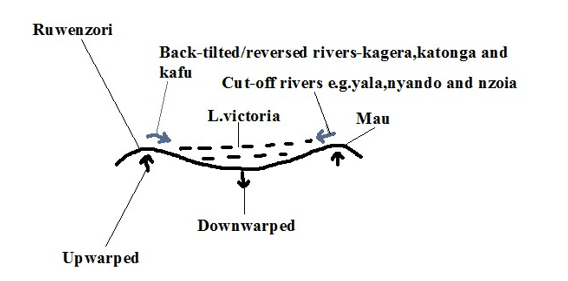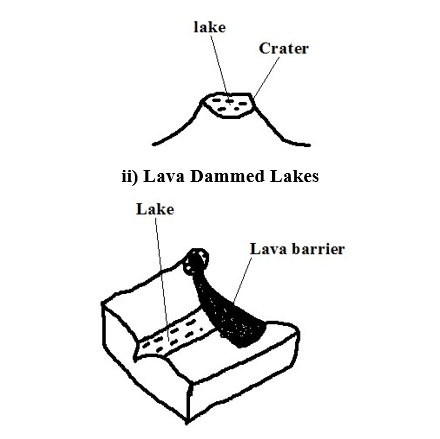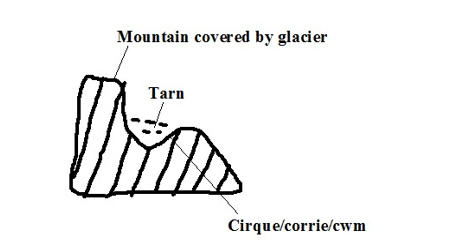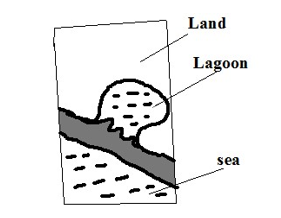A lake is a depression on the earth‟s surface where water has accumulated.
Classification /Types of Lakes
According To the Nature of Water
- Fresh water lakes which contain fresh water.
- Salty lakes which have salty water.
According To the Mode of Formation of Depression They Occupy
- by Earth or Tectonic Movements
- Faulted or Rift Valley Lakes
- During Rift Valley formation some parts of the rift valley floor sunk more than others.
- A long narrow and deep depression formed.
- Water from seepage and rain accumulated into these depressions to form lakes.
Down Warped and Tilted Lakes

Tensional and compression forces caused some parts of the earths crust to up warp while others down warped.
- A shallow depression formed. o The depression may also be filled with water from rain or ground water.
- In the case of L. Victoria Rivers Kafu, Kagera and Katonga were tilted eastwards and Nyando, Yala and Nzoia continued flowing west wards adding water into the depression.
- Victoria is the second largest fresh water lake after L.Superior.
- Has a maximum depth of 87m deep. Other examples of lakes are L. Kyoga and Wamala.
Playas/sebkha is a lake contained in an inland drainage basin in a desert formed when rain or flood water flows into a basin formed by crustal warping e.g. Chemchane Sebkha in Mauritania.
2. by Vulcanicity
Crater Lakes – Lake formed by water accumulating into a crater.
- Are usually salty.
- A crater lake formed on an explosion crater is called maar.
- Examples are Lakes Mossoko in Tanzania, Paradise in Marsabit and Myungu in Uganda.

- Formed as a result water accumulating on the upstream side of a lava barrier across a river.
- Highly viscous lava erupts across a rivers course.
- It solidifies and blocks the river forming a lava dam.
- The rivers water accumulates behind the lava dam.
- A narrow and winding lake is formed e.g. Lakes Bunyonyi, Mutanda and Bulera in Uganda.
3. by Erosion
Glacial Erosion
Corrie/Tarn Lakes

Lake formed when water from melting snow accumulates into a corrie/cirque e.g. Teleki, Nanyuki and Hidden tarns on Mt. Kenya.
Ribbon Lakes – Finger like on a glaciated valley.
- Glacier erodes the floor of a u-shaped valley. o It over deepens some of its sections. o Elongated hollow results.
- Water from melting ice accumulates into it forming a lake.

Wind Erosion
Lakes formed when ground water accumulates in a depression formed by wind deflation and abrasion.
- Wind continuously erodes the earths crust by deflation and abrasion.
- The water bearing rocks are reached.
Water oozes from the water table into the hollow or water from flash floods may accumulate in it to form temporary lakes called pans e.g. in Quattara depression between Egypt and Libya and Etosha pan in Namib.
Solution Lakes
- Lakes formed when rain or ground water accumulates in depressions formed in limestone rocks when rain water containing a weak carbonic acid dissolves limestone rocks e.g. Lakes Barber in Morrocco and Ojikoto in Namibia.
- by Deposition
River Deposition
- Formed when river deposition occur cutting off a section of a pronounced meander e.g. oxbow lakes Shakababo and Mukunguya at lower part of Tana.
Wave Deposition

- Lakes formed when wave deposition occurs across a rivers mouth or where the coastline changes suddenly enclosing a body of calm water.
- Waves break at an angle.
- The long shore drift causes materials to be progressively arranged across a rivers mouth resulting in a body of calm water called a lagoon/sound.
- by Man
Dams are Lakes formed when water accumulates behind dams constructed across rivers resulting into a large man made reservoir called man made lake e.g. behind Seven Forks Dam and Lakes Volta in Ghana and Nasser in Egypt.
Barrage is a bank of earth or stones built across a river to provide water for farming.
Significance of Lakes
Positive
- Fresh water lakes provide water for domestic and industrial use.
- Fresh water lakes also provide water for irrigation e.g. Naivasha for horticultural farms around it.
- Man made lakes and some other lakes e.g. Victoria (Owen falls) are used for generation of H.E.P.
- Lakes are used for transport.
- Some lakes contain valuable minerals e.g. trona at L. Magadi and salt at L. Katwe in Uganda.
- Many lakes have fish which is a source of food and employment to fishermen and traders.
- Lakes are also a tourist attraction by providing recreational facilities and being habitats for wildlife.
- Some lakes are sources of rivers e.g. Victoria for White Nile and L.Tana for Blue Nile.
- Lakes modify the climate of surrounding areas by sea breezes and convectional rainfall.
Negative
- Lakes are habitats for disease vectors e.g. mosquitoes and snails which transmit Malaria and bilhazia.
- Lakes may cause flooding due to excessive rainfall or when dams break leading to loss of life and property.
- Lakes are habitats for dangerous animals like crocodiles, hippos and snakes which kill humans.
- Lakes cause drowning accidents to people in time of storms.
